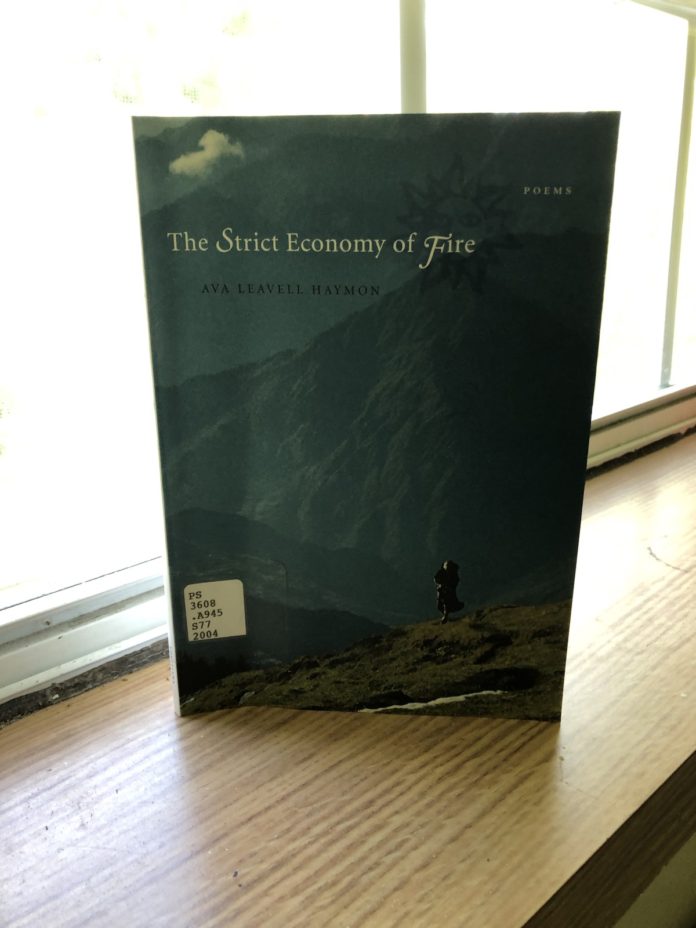Welcome to Lit Review, where columnist Dominiq Wilson will take apart a series of chapbooks to figure out what works and what doesn’t for the modern reader of poetry.
We’re starting off May Term with The Strict Economy of Fire, a 31-poem collection written by Ava Leavell Haymon. I chose to read this book because of its interesting title and soon found that it was more than just a collection.
This book acted more like a travel journal of sorts, and I didn’t realize it until I was almost halfway through the book. At first, I just noted that a lot of the poems seemed to refer back to each other, but as movement was implied within the poems, I realized that the narrator was moving from one place to another. Take “Rhododendron Forest on the Last Ascent” for example:
A rhododendron forest gathers around us,
mother thighs twisting out of the ground
amber and pink, here and there glazed
with a thin gold leaf of morning sun.
Earlier, Ganesh loomed over us, porcelain white,
the long ridge trending off southwest,
glaciers without pity, harsh granite the gable beam
of the world. Now this lush screen enfolds us—
boles the shape of human limbs, muscled legs, a peeling
skin three-colored as the sycamore we know at home.
Ferns, banj lichen pillow the rocks. Giant trunks
of hemlock, burnt out hollow, to crawl in and sleep.
The sprigs of Buddha plant we carry from below
encourage our climb with the smell of tangerines
and lavender. Little seed heads of hope.
We will leave them
at the pass, if we make it there,
at the stupa, if there is one so high,
if we can bear to leave these arms.
There were many interesting poems in this rather large collection, but I also noted a few that, to me, felt like filler poems. The majority of the poems speak about something for a lengthy amount of time, so the ones that didn’t do that, to me, could have been expanded upon or excluded. But I also understanding the nature of traveling, and excitement isn’t around every corner. In terms of following this traveling journey, I think that adding these filler poems was strategic, but within a collection of poems, I found the energy of these poems to be lacking compared to the others in the collection.
The most interesting poems I found were in a series, which there were quite a few of in this collection. The majority of them have at least two parts, but the longest series of poems is titled “First Smoke,” which has eight parts and describes the set of fires the narrator sees as they hike up a mountain. Fortunately for me, the first two parts of this series were my favorite, which I’m happy to share with you below:
i
From hazy blue black shadows, a slanting
first sun picks out creases in the earth
the homey color of pecan shells.
A thousand identical mountains—
I count the one we are on—
and the one next in front of us
sends up a balloon of smoke.
Too far away to show flames,
the plume billows fat and puffy,
then steadies to narrow streamers.
Another puff! woman’s voice behind me
in the single file. And another: Look—a third!
Who would set such fires? at such altitude,
higher than villages? The smoke slips straight up
against an indigo ground, three birthday candles
lit at one time. All through the morning,
the lines of white crawl sideways, stretching
to meet for ring-around-the-rosy. By noon,
the ring is complete. The birthday girl has tossed
her hoop. One peak out of all the others burns,
burns upwards, slow as an hour hand,
at this great distance.
ii
Cremation fires, Ming Mah tells us
when we all stop for lunch. This far
from rivers, the dead are carried higher
and burned near mountaintops.
The imagery of birthday candles and the reality of cremation rituals were almost a juxtaposition of events. While one event celebrates one more year of a happy, healthy life, the other is a grieving celebration for a life cut short. It’s definitely morbid in its own way, but I really enjoyed how imagination and reality clash in such an interesting way, here. I highly suggest you read the rest of the series if you have the chance!
I’ve never read a book with a timeline like this before, and I highly suggest that you read it! We have a copy in our campus library, and it’s also available for purchase on Louisiana State University Press’s website for around $17.



